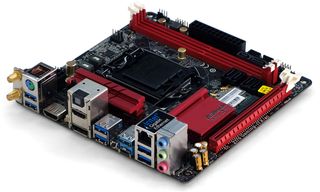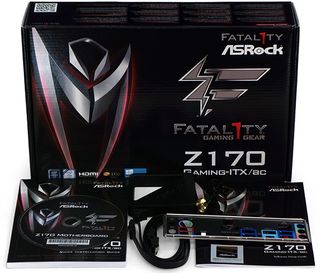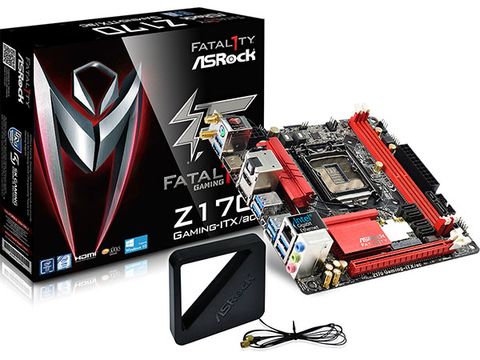Early Verdict
ASRock’s Fatal1ty Z170 Gaming-ITX/ac sets the standard for high-end Mini ITX Skylake overclocking.
Pros
- +
CPU overclocking
- +
DTS Connect, PCIe on SATA-E independent of shared SATA connection
- +
Under-board M.2 connector
- +
Wi-Fi/Bluetooth controller
Cons
- -
Analog audio connectors
- -
memory overclocking
Why you can trust Tom's Hardware
Introduction, Specifications & Features
Previously a staple of office machines and entertainment PCs, Mini ITX became big business in the enthusiast PC market almost as quickly as manufacturers could shift their focus away from Micro ATX. It seems that the portable gaming PC market wasn't all that interested in SLI, and wouldn't need the extra slots afforded by Micro ATX for anything else.
That's not to say there haven't been growing pains, as the first Mini ITX cases were designed for AMD's failed DTX form factor. Indeed, the need for the case to have two slots continues as graphics card coolers remain two-slots thick. ITX remains constrained in the placement of drive connectors and voltage regulator components, yet companies continue to develop enthusiasts-level boards through a mix of engineering competence and sheer determination.
ASRock's latest foray into the compact gaming market comes with all the things needed specifically for that market, such as a voltage regulator large enough to support moderate overclocks, a high-performance Intel-supplied network port, an 867 megabit 2x2 Wi-Fi controller, and an M.2 slot that's hidden underneath so it won't consume as much space on the crowded top side. Knowing that overclockers often need to clear their firmware settings without digging around inside a crowded Mini ITX case, ASRock adds a recessed CLR_CMOS button to the I/O panel. The Z170 Gaming-ITX/ac even includes a third fan port where many of its competitors have two, since enthusiast gaming cases have both intake and exhaust fans in addition to the CPU cooler.
We even find a pair of USB 3.1 headers as Type A and Type-C, just in case you need to transfer a game via a 10 Gbps drive.
MORE: Best MotherboardsMORE:
How To Choose A Motherboard
MORE: All Motherboard Content
Features
We just discussed how the Fatal1ty Z170 Gaming-ITX/ac might be a great gaming board layout, but it also has a few media-center-oriented features, such as its dual 4k-display supporting HDMI 2.0 ports and live encoding of multi-channel audio streams to a single digital output via DTS Connect. Yet the presence of only three rear-panel analog audio ports is a little perplexing, since anyone who doesn't have a DTS receiver will need to configure all three connectors as 5.1 analog output in order to accomplish true positional audio from non-encoded sources such as games. That doesn't leave any inputs, apart from the front-panel connector.

It's not as if there isn't space for the extra connectors, it's just that ASRock appears to believe this is no longer needed by most enthusiasts. That may be true, but we still remember that ASRock was still putting VGA connectors on enthusiast motherboards not-so-long-ago.

Little things make a big difference in Mini ITX internal layout, and some of ASRock’s big ideas include the PCIe 3.0 x4 M.2 connector being placed under the motherboard and the Front-Panel audio header being placed above the graphics card slot. The M.2 connector is also compatible with SATA drives, and ASRock made the smart choice of sharing only those SATA connections with the top-side SATA-Express port. That means the SATA-Express PCIe ports are always-on, and always-capable of supporting ASRock's own USB 3.1 bay device, if you can find anyone selling it separately.
Intel's LGA-1151 package appears perfectly situated for mounting 120mm coolers on the Z170 Gaming-ITX/ac, leaving around 1.3" of extra space for heat pipes (on downdraft-style coolers) between the fan and graphics cards. That also leaves space for even larger coolers, if they're offset in the proper directions to fit your specific case. The two caveats of using a large cooler with this board is that it needs to have clearence for whatever RAM is chosen, and that some of that same space is also needed for the four SATA ports on the CPU-side of the DIMM slots. The other two SATA ports, though shared with M.2, remain active if the M.2 SSD is PCIe-based.

The Z170 Gaming-ITX/ac includes two SATA cables and a Wi-Fi antenna. That's probably enough added hardware, given its intended use in Mini-ITX cases.
-
honkuimushi I built a system using this board last week and I'm writing this comment on it right now. It's still early, but I like it so far. I got it because it was one of 2 mini-ITX boards that had both USB 3.1(A&C), and an M.2 slot. And it had about double the USB 3.0 ports that the competing Gigabyte board had.Reply
I notice you were using the P1.2 BIOS. When I built this, the current BIOS was 1.5 and one of the major parts of the updates was memory compatibility. I wonder if you'd have any better luck with your memory issues with a newer BIOS. I'm using Ripajaws V @ 2800MHz with a locked i7 6700. It took some fiddling to get it to boot with both sticks in, but eventually it worked with the default XMP profile. -
Crashman Reply
Perhaps. It took 10 weeks to get this one published :(17131026 said:I built a system using this board last week and I'm writing this comment on it right now. It's still early, but I like it so far. I got it because it was one of 2 mini-ITX boards that had both USB 3.1(A&C), and an M.2 slot. And it had about double the USB 3.0 ports that the competing Gigabyte board had.
I notice you were using the P1.2 BIOS. When I built this, the current BIOS was 1.5 and one of the major parts of the updates was memory compatibility. I wonder if you'd have any better luck with your memory issues with a newer BIOS. I'm using Ripajaws V @ 2800MHz with a locked i7 6700. It took some fiddling to get it to boot with both sticks in, but eventually it worked with the default XMP profile.
-
2Be_or_Not2Be It seems all of the comparison boards are micro-ATX. Why not compare with another feature-comparable mini-ITX board, like the Gigabyte Z170N Gaming 5?Reply -
Croc Ography I would love to get this board, but Newegg in Canada cannot seem to get their act in gear and import the thing. It has been selling fairly well in their US store for over a couple of months already but no love for Canada.Reply
Great and timely article though, I really appreciate these reviews immensely. Thank you very much. -
ppalm I have this motherboard, but unfortunately haven't been able to use it yet. I've tried moving the main drive over from my main system without reinstalling anything but couldn't get the USB ports to work (possibly due to win7), so I can't install drivers and whatnot. I tried to 'preinstall' drivers and then shut down my main system and move the drive over and still couldn't get it to work. Its a very frustrating experience.Reply
All this because I was building a mini ITX box to move my system into while troubleshooting my main Skylake problem system (black screen hangs narrowed down to motherboard as the likely culprit). So in trying to avoid a problem, I experienced more difficulties.
The only thing I didn't like about it was having only 3 fan headers, but that's common among ITX systems. I needed 4 headers so I bought a splitter. The cooling is a bit of a tight squeeze but fits too - I have a Noctua U9 series and the mounting bracket sits about 1mm above the VRM, while the fan is about 1mm from the heatspreader-covered ram (standard mounting, pointing towards the case rear blowing through the heatsink). -
Moneyd623 ReplyI built a system using this board last week and I'm writing this comment on it right now. It's still early, but I like it so far. I got it because it was one of 2 mini-ITX boards that had both USB 3.1(A&C), and an M.2 slot. And it had about double the USB 3.0 ports that the competing Gigabyte board had.
I notice you were using the P1.2 BIOS. When I built this, the current BIOS was 1.5 and one of the major parts of the updates was memory compatibility. I wonder if you'd have any better luck with your memory issues with a newer BIOS. I'm using Ripajaws V @ 2800MHz with a locked i7 6700. It took some fiddling to get it to boot with both sticks in, but eventually it worked with the default XMP profile.
I've had the board for almost two months now, and have almost no complaints. Like you, I'm using the locked i7 6700, and I had issues initially getting the RAM OC settings down, but once everything was stable, it worked great.... as long as I don't mess with the settings anymore.
Couple of issues though... I really wanted to use the Ultra Fast boot (the setting that skips the bios completely), to try and get system boot to sub 3 seconds (it's about 6-7 seconds now to desktop), but when that setting is enabled, anytime I attempt to go back to bios using the ASRock "reset to bios" tool, I can't boot properly again without resetting all my bios settings. Same problem experienced when using the windows "reset to bios" setting as well.
Additionally, the little piece of bent metal that the Bluetooth and WiFi antenna connectors are attached to is useless. Mine is partially broken (one of the connectors is no longer locked in place and spins unabated), and the metal is not bent correctly in place. It is slightly shifted to one side, but that's more of a minor annoyance I guess.
Also +1 on the fan headers comment, also had to get a splitter. -
Crashman Reply
HEY GIGABYTE, your Z170N Gaming 5 is required. Please step out of the shadows and join us.17131345 said:It seems all of the comparison boards are micro-ATX. Why not compare with another feature-comparable mini-ITX board, like the Gigabyte Z170N Gaming 5?
You're correct, the standard for Mini ITX is two, and better-feature boards usually have three.17133014 said:The only thing I didn't like about it was having only 3 fan headers, but that's common among ITX systems. I needed 4 headers so I bought a splitter. The cooling is a bit of a tight squeeze but fits too - I have a Noctua U9 series and the mounting bracket sits about 1mm above the VRM, while the fan is about 1mm from the heatspreader-covered ram (standard mounting, pointing towards the case rear blowing through the heatsink). -
g-unit1111 Nice to see that mITX is becoming more of a thing and that more manufacturers are starting to release higher end motherboards to cater to people buying much smaller PCs.Reply -
Wamphryi I love the idea on Mini ITX after years of full towers crowding my office space but the lack of SLI is an issue I cannot put to one side as I rely on SLI to power my 4K setup.Reply


